

Ten facts about the economics of climate change and climate policy. Fact 1: Damages to the U.S. economy grow with temperature change at an increasing rate.
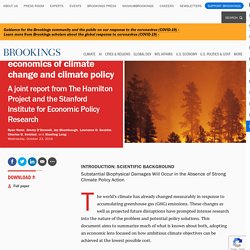
The physical changes described in the introduction will have substantial effects on the U.S. economy. Climate change will affect agricultural productivity, mortality, crime, energy use, storm activity, and coastal inundation (Hsiang et al. 2017). In figure 1 we focus on the economic costs imposed by climate change in the United States for different cumulative increases in temperature. It is immediately apparent that economic costs will vary greatly depending on the extent to which global temperature increase (above preindustrial levels) is limited by technological and policy changes. At 2°C of warming by 2080–99, Hsiang et al. (2017) project that the United States would suffer annual losses equivalent to about 0.5 percent of GDP in the years 2080–99 (the solid line in figure 1). There is, of course, substantial uncertainty in these calculations. Also evident in figure 4 is the role of income.
What is transparency and reporting? IPCC — Intergovernmental Panel on Climate Change. Paris Agreement - Negotiations and agreement. One of the main sticking points of the negotiations was the issue of transferring funds from developed countries to LDCs, because developed countries did not want to be the only ones paying the costs.
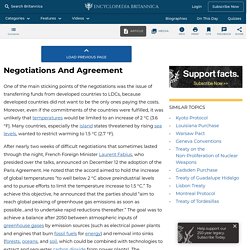
Moreover, even if the commitments of the countries were fulfilled, it was unlikely that temperatures would be limited to an increase of 2 °C (3.6 °F). Many countries, especially the island states threatened by rising sea levels, wanted to restrict warming to 1.5 °C (2.7 °F). After nearly two weeks of difficult negotiations that sometimes lasted through the night, French Foreign Minister Laurent Fabius, who presided over the talks, announced on December 12 the adoption of the Paris Agreement.
NPR Choice page. What is the Paris Agreement? At COP 21 in Paris, on 12 December 2015, Parties to the UNFCCC reached a landmark agreement to combat climate change and to accelerate and intensify the actions and investments needed for a sustainable low carbon future.
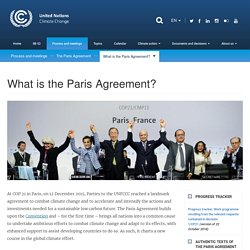
The Paris Agreement builds upon the Convention and – for the first time – brings all nations into a common cause to undertake ambitious efforts to combat climate change and adapt to its effects, with enhanced support to assist developing countries to do so. As such, it charts a new course in the global climate effort. The Paris Agreement. What is the Paris Agreement?
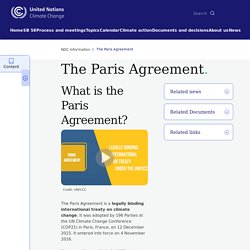
The Paris Agreement is a legally binding international treaty on climate change. It was adopted by 196 Parties at COP 21 in Paris, on 12 December 2015 and entered into force on 4 November 2016. Its goal is to limit global warming to well below 2, preferably to 1.5 degrees Celsius, compared to pre-industrial levels. To achieve this long-term temperature goal, countries aim to reach global peaking of greenhouse gas emissions as soon as possible to achieve a climate neutral world by mid-century.
Center for Climate and Energy Solutions. Global Maps. Global Warming vs. Climate Change. “Climate change” and “global warming” are often used interchangeably but have distinct meanings.

Similarly, the terms "weather" and "climate" are sometimes confused, though they refer to events with broadly different spatial- and timescales. Weather vs. Climate “If you don’t like the weather in New England, just wait a few minutes.” Weather refers to atmospheric conditions that occur locally over short periods of time—from minutes to hours or days. Climate, on the other hand, refers to the long-term regional or even global average of temperature, humidity and rainfall patterns over seasons, years or decades.
What is Global Warming? Global warming is the long-term heating of Earth’s climate system observed since the pre-industrial period (between 1850 and 1900) due to human activities, primarily fossil fuel burning, which increases heat-trapping greenhouse gas levels in Earth’s atmosphere. Climate Action Tracker. Search: paris agreement. PBS/NASA Modules. Note: This section contains archival content that is no longer maintained.
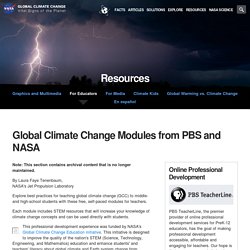
By Laura Faye Tenenbaum, NASA's Jet Propulsion Laboratory Explore best practices for teaching global climate change (GCC) to middle- and high-school students with these free, self-paced modules for teachers. Each module includes STEM resources that will increase your knowledge of climate change concepts and can be used directly with students. This professional development experience was funded by NASA's Global Climate Change Education initiative.
This initiative is designed to improve the quality of the nation's STEM (Science, Technology, Engineering, and Mathematics) education and enhance students' and teachers' literacy about global climate and Earth system change from elementary grades to lifelong learners.